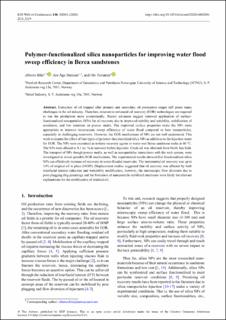| dc.contributor.author | Bila, Alberto Luis | |
| dc.contributor.author | Stensen, Jan Åge | |
| dc.contributor.author | Torsæter, Ole | |
| dc.date.accessioned | 2020-10-26T13:41:27Z | |
| dc.date.available | 2020-10-26T13:41:27Z | |
| dc.date.created | 2020-05-19T15:39:12Z | |
| dc.date.issued | 2020 | |
| dc.identifier.citation | E3S Web of Conferences. 2020, 146 (02001), . | en_US |
| dc.identifier.issn | 2267-1242 | |
| dc.identifier.uri | https://hdl.handle.net/11250/2685062 | |
| dc.description.abstract | Extraction of oil trapped after primary and secondary oil production stages still poses many challenges in the oil industry. Therefore, innovative enhanced oil recovery (EOR) technologies are required to run the production more economically. Recent advances suggest renewed application of surface-functionalized nanoparticles (NPs) for oil recovery due to improved stability and solubility, stabilization of emulsions, and low retention on porous media. The improved surface properties make the NPs more appropriate to improve microscopic sweep efficiency of water flood compared to bare nanoparticles, especially in challenging reservoirs. However, the EOR mechanisms of NPs are not well understood. This work evaluates the effect of four types of polymer-functionalized silica NPs as additives to the injection water for EOR. The NPs were examined as tertiary recovery agents in water-wet Berea sandstone rocks at 60 °C. The NPs were diluted to 0.1 wt. % in seawater before injection. Crude oil was obtained from North Sea field. The transport of NPs though porous media, as well as nanoparticles interactions with the rock system, were investigated to reveal possible EOR mechanisms. The experimental results showed that functionalized-silica NPs can effectively increase oil recovery in water-flooded reservoirs. The incremental oil recovery was up to 14% of original oil in place (OOIP). Displacement studies suggested that oil recovery was affected by both interfacial tension reduction and wettability modification, however, the microscopic flow diversion due to pore plugging (log-jamming) and the formation of nanoparticle-stabilized emulsions were likely the relevant explanations for the mobilization of residual oil. | en_US |
| dc.language.iso | eng | en_US |
| dc.publisher | EDP Sciences | en_US |
| dc.rights | Navngivelse 4.0 Internasjonal | * |
| dc.rights.uri | http://creativecommons.org/licenses/by/4.0/deed.no | * |
| dc.subject | Polymer-functionalized silica | en_US |
| dc.subject | Crude oil | en_US |
| dc.subject | Surface functionalized nanoparticles | en_US |
| dc.subject | water-flooded reservoirs | en_US |
| dc.title | Polymer-functionalized silica nanoparticles for improving water flood sweep efficiency in Berea sandstones. | en_US |
| dc.type | Peer reviewed | en_US |
| dc.type | Journal article | en_US |
| dc.description.version | publishedVersion | en_US |
| dc.rights.holder | © The Authors, published by EDP Sciences. This is an open access article distributed under the terms of the Creative Commons Attribution License 4.0 (http://creativecommons.org/licenses/by/4.0/). | en_US |
| dc.source.pagenumber | 12 | en_US |
| dc.source.volume | 146 | en_US |
| dc.source.journal | E3S Web of Conferences | en_US |
| dc.source.issue | 02001 | en_US |
| dc.identifier.doi | 10.1051/e3sconf/202014602001 | |
| dc.identifier.cristin | 1811758 | |
| dc.relation.project | Norges forskningsråd: 262644 | en_US |
| cristin.ispublished | true | |
| cristin.fulltext | original | |
| cristin.qualitycode | 1 | |

